-
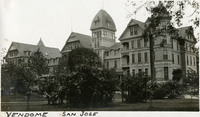 McCarthy Album 03, Photograph 100
McCarthy Album 03, Photograph 100 Caption: "Vendome San Jose," c. 1910, was a luxury hotel in San Jose that opened in 1889. It was purchased by a real estate syndicate in 1930 and subsequently demolished in order to subdivide the property into lots for residential housing.
-
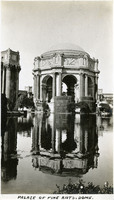 McCarthy Album 03, Photograph 099
McCarthy Album 03, Photograph 099 Caption: "Palace of Fine Arts, Dome," built for the Panama-Pacific International Exposition, 1915.
-
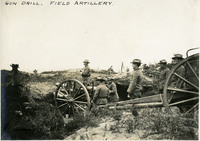 McCarthy Album 03, Photograph 098
McCarthy Album 03, Photograph 098 Caption: "Gun Drill, Field Artillery," Unidentified location, undated.
-
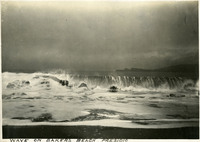 McCarthy Album 03, Photograph 097
McCarthy Album 03, Photograph 097 Caption: "Wave on Bakers [sic] Beach Presidio," San Francisco, c. 1906.
-
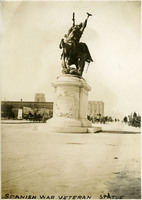 McCarthy Album 03, Photograph 096
McCarthy Album 03, Photograph 096 Caption: "Spanish War Veteran Statue," shows the Spanish-American War Memorial in San Francisco, c. 1906.
-
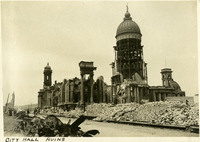 McCarthy Album 03, Photograph 095
McCarthy Album 03, Photograph 095 Caption: "City Hall Ruins," shows the gutted San Francisco City Hall after the 1906 earthquake and fires. Considered one of the worst natural disasters in the country's history, the 1906 San Francisco earthquake and resulting fires killed an estimated 3,000 people and destroyed over 500 city blocks, leaving approximately 200,000 residents homeless.
-
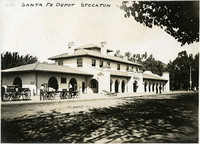 McCarthy Album 03, Photograph 094
McCarthy Album 03, Photograph 094 Caption: "Santa Fe Depot, Stockton," c. 1906. The Santa Fe Depot (William Benson Storey, architect) was completed in 1899 for the Atchison, Topeka, and Santa Fe Railway. Added to the National Register of Historic Places in 1976, the depot was renovated and restored it to its original design, and reopened in 2005.
-
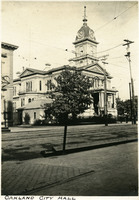 McCarthy Album 03, Photograph 093
McCarthy Album 03, Photograph 093 Caption: "Oakland City Hall," Oakland, California, c. 1910. Completed in 1879, the building was Oakland's second city hall and served until it was demolished in 1914 to create City Hall Plaza in front of the new City Hall that had been completed that year.
-
 McCarthy Album 03, Photograph 092
McCarthy Album 03, Photograph 092 Caption: "Stockton Asylum Grounds," Stockton, California, c. 1906. The Stockton Insane Asylum was established in 1851, completed in 1853, and was the first public mental health hospital in California. It remained a functioning state hospital until 1995.
-
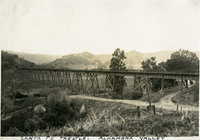 McCarthy Album 03, Photograph 091
McCarthy Album 03, Photograph 091 Caption: "Santa Fe Trestle, Alhambra Valley," Martinez, Contra Costa County, California, c. 1906.
-
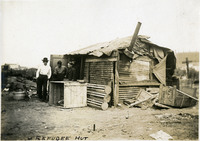 McCarthy Album 03, Photograph 090
McCarthy Album 03, Photograph 090 Caption: "Refugee Hut," shows four people standing in the doorway of a hut built after the San Francisco earthquake of April 18, 1906. Considered one of the worst natural disasters in the country's history, the 1906 San Francisco earthquake and resulting fires killed an estimated 3,000 people and destroyed over 500 city blocks, leaving approximately 200,000 residents homeless.
-
 McCarthy Album 03, Photograph 089
McCarthy Album 03, Photograph 089 Caption: "Benicia Arsenal Entrance," c. 1905, Benicia, California. William McCarthy began his career as an inspector of armaments for the U.S. War Department at the Benicia Arsenal in 1903. The arsenal was established in 1851 as the first Ordnance Supply Depot in the West, from which it supplied and supported U.S. troops, from the Civil War through WWII and the Korean War. It was deactivated in 1963.
-
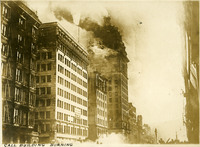 McCarthy Album 03, Photograph 088
McCarthy Album 03, Photograph 088 Caption: "Call Building Burning," shows the Call Building on Market and 3rd Streets on fire after the earthquake, with people and horses in the foreground. Considered one of the worst natural disasters in the country's history, the 1906 San Francisco earthquake and resulting fires killed an estimated 3,000 people and destroyed over 500 city blocks, leaving approximately 200,000 residents homeless.
-
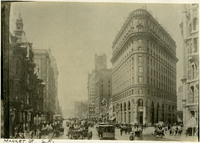 McCarthy Album 03, Photograph 087
McCarthy Album 03, Photograph 087 Caption: "Market St. S.F." Shows Market Street with intact buildings, trolleys, horse-drawn buggies and carriages, and people milling about. Most likely before the April 18, 1906 earthquake. C. 1905.
-
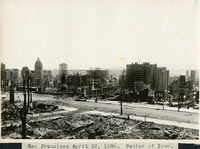 McCarthy Album 03, Photograph 086
McCarthy Album 03, Photograph 086 Caption: "San Francisco April 22, 1906. Center of Town." Shows the city center in ruins after the earthquake and fires. Considered one of the worst natural disasters in the country's history, the 1906 San Francisco earthquake and resulting fires killed an estimated 3,000 people and destroyed over 500 city blocks, leaving approximately 200,000 residents homeless.
-
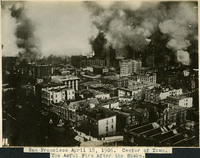 McCarthy Album 03, Photograph 085
McCarthy Album 03, Photograph 085 Caption: "San Francisco April 18, 1906. Center of Town. The Awful Fire after the Shake." Shows much smoke with buildings on fire in the center of the city, after the earthquake. Considered one of the worst natural disasters in the country's history, the 1906 San Francisco earthquake and resulting fires killed an estimated 3,000 people and destroyed over 500 city blocks, leaving approximately 200,000 residents homeless.
-
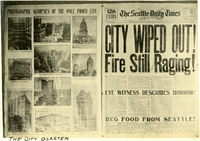 McCarthy Album 03, Photograph 084
McCarthy Album 03, Photograph 084 Caption: "The City Disaster." Photograph of The Seattle Daily Times front page and photographs of the San Francisco earthquake's aftermath with headline: "City Wiped Out! Fire Still Raging!" Dated April 20, 1906.
-
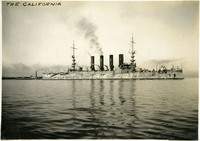 McCarthy Album 03, Photograph 083
McCarthy Album 03, Photograph 083 Caption: "The California. " c. 1906. This photograph shows the second U.S. Navy ship to bear the Golden State's name. Launched in 1904 and commissioned in 1907, this Pennsylvania-class armored cruiser served in the Pacific fleet. Her name was changed in 1914 to the USS San Diego, in order to free up the name for a new, Tennessee-class battleship. The USS San Diego went on to serve in both the Pacific and Atlantic fleets during World War I, until being sunk off the coast of New York by a German mine in 1918, with a loss of six lives.
-
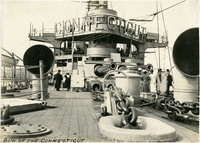 McCarthy Album 03, Photograph 082
McCarthy Album 03, Photograph 082 Caption: "Bow of the Connecticut," unidentified location, undated.
-
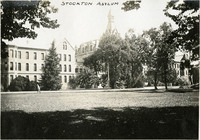 McCarthy Album 03, Photograph 081
McCarthy Album 03, Photograph 081 Caption: "Stockton Asylum." Stockton, California, c. 1906. The Stockton Insane Asylum was established in 1851, completed in 1853, and was the first public mental health hospital in California. It remained a functioning state hospital until 1995.
-
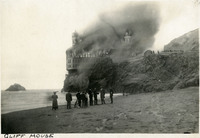 McCarthy Album 03, Photograph 080
McCarthy Album 03, Photograph 080 Caption: "Cliff House." People standing on Ocean Beach watching the third Cliff House burning in San Francisco, in 1907. The original Cliff House was built in 1858. The second was built in 1863 and was destroyed by fire on Christmas day in 1894. The third Victorian- style Cliff House was completed in 1896, and although it survived the 1906 earthquake and fires, it burned to the ground in 1907, as seen in this image. A fourth Cliff House was then built with steel-reinforced concrete and opened in 1909.
-
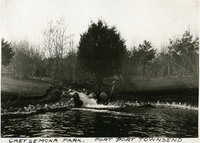 McCarthy Album 03, Photograph 079
McCarthy Album 03, Photograph 079 Caption: "Chetzemoka Park. Port Townsend." Washington, c. 1905.
-
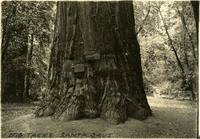 McCarthy Album 03, Photograph 078
McCarthy Album 03, Photograph 078 Caption: "Big Trees Santa Cruz." General Grant, located in the Santa Cruz Big Tree Grove, c. 1905.
-
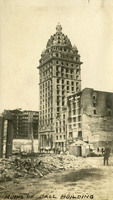 McCarthy Album 03, Photograph 077
McCarthy Album 03, Photograph 077 Caption: "Ruins of Call Building." Completed in 1898 and designed by civic leader Claus Spreckels, the Call building on the corner of 3rd and Market streets was one of the first skyscrapers in San Francisco, built to house the San Francisco Call newspaper offices. While the structure withstood the 1906 earthquake, the interior caught fire and sustained considerable damage. After major renovations, the building is today known as The Central Tower.
-
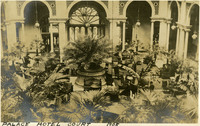 McCarthy Album 03, Photograph 076
McCarthy Album 03, Photograph 076 Caption: "Palace Hotel Court 1905," c. 1906. (Handwritten on photograph: "copyright 1906 by W._ Wod_n."). The Palace Hotel was originally built in 1875, rebuilt in 1909, and was one of the first premier luxury hotels in San Francisco.
-
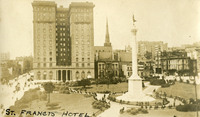 McCarthy Album 03, Photograph 075
McCarthy Album 03, Photograph 075 Caption: "St. Francis Hotel," c. 1905. St. Francis Hotel at Union Square and the Dewey Monument in the foreground (Robert I. Aitken, sculptor), which commemorated U.S. Admiral George Dewey's naval victory at the battle of Manila Bay during the Spanish American War of 1898. The luxury hotel opened in 1904 and fortunately suffered little damage from the 1906 earthquake. It was expanded in 1913, and 1972, making it one of the largest hotels in the city.
-
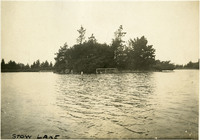 McCarthy Album 03, Photograph 074
McCarthy Album 03, Photograph 074 Caption: "Stow Lake," in Golden Gate Park, San Francisco, c. 1910. Stow lake is a manmade lake in Golden Gate Park dating back to 1893. Visitors still enjoy Stow Lake today, engaging in activities such as boating and picnicking by the lake.
-
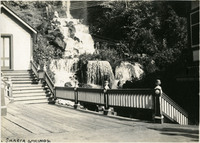 McCarthy Album 03, Photograph 073
McCarthy Album 03, Photograph 073 Caption: "Shasta Springs," Siskiyou County, California, c. 1906. Shasta Springs, just north of Dunsmuir, California, in the Trinity Mountains, was a resort area in the late nineteenth and early twentieth centuries. It centered around natural springs, which became a featured stop on the Southern Pacific Railroad's Shasta Route. The resort operated until the 1950s, when it was purchased by private interests.
-
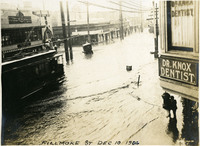 McCarthy Album 03, Photograph 072
McCarthy Album 03, Photograph 072 Caption: "Fillmore St. Dec 10, 1906." Shows the Fillmore Street area flooded, San Francisco, 1906.
-
 McCarthy Album 03, Photograph 071
McCarthy Album 03, Photograph 071 Caption: "The Massachusetts," Ship designed for coastal defense. Unidentified location, undated.
-
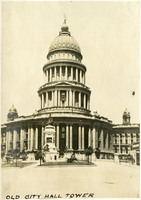 McCarthy Album 03, Photograph 070
McCarthy Album 03, Photograph 070 Caption: "Old City Hall Tower," San Francisco, c. 1905. A view of the San Francisco City Hall, built in 1870, before it was damaged beyond repair by the 1906 earthquake and fires. A new city hall, near the site of the original, was completed in 1916.
-
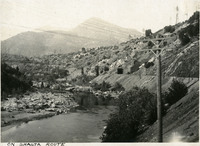 McCarthy Album 03, Photograph 069
McCarthy Album 03, Photograph 069 Caption: "On Shasta Route," Siskiyou County, California, c. 1905
-
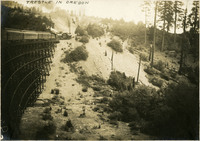 McCarthy Album 03, Photograph 068
McCarthy Album 03, Photograph 068 Caption: "Trestle in Oregon." c. 1905
-
 McCarthy Album 03, Photograph 067
McCarthy Album 03, Photograph 067 Caption: " Parliament Building Victoria B.C." c. 1909. Constructed in the Neo-baroque, Renaissance Revival and Romanesque Revival architectural style (Francis Rattenbury, architect), the British Columbia Parliament Buildings were completed in 1897, and are home to the Legislative Assembly of British Columbia.
-
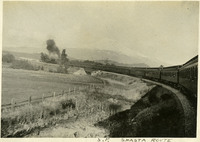 McCarthy Album 03, Photograph 066
McCarthy Album 03, Photograph 066 Caption: "S.P. Shasta Route." Southern Pacific train on the Shasta route with Mt. Shasta in the background, c. 1905.
-
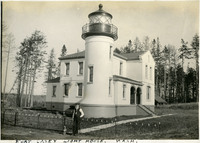 McCarthy Album 03, Photograph 065
McCarthy Album 03, Photograph 065 Caption: "Fort Casey Light House, Wash." c. 1905. Located on Whidbey Island in Puget Sound, the Admiralty Head Lighthouse was built overlooking Admiralty Inlet in 1903. It replaced an earlier structure that had to be moved in 1890 to accommodate the construction of Fort Casey. The second lighthouse, shown here, was built with thick walls in order to withstand earthquakes and the concussion of guns at Fort Casey. The man shown in the photograph is likely Charles H. Davis, who was appointed keeper of the lighthouse in 1900 and served until his death in 1914. The lighthouse, deactivated in 1922, has since been restored by Washington State Parks, and is part of the Fort Casey State Park.
-
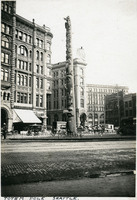 McCarthy Album 03, Photograph 064
McCarthy Album 03, Photograph 064 Caption: "Totem Pole, Seattle." Seattle, Washington, c. 1905. View of the Tlingit totem pole in Seattle's Pioneer Square. The totem pole was stolen in 1899 by a group of businessmen, and erected in the square, then known as Pioneer Place. An arsonist destroyed this pole in 1938, but it was later replaced by another carved by the Tlingit tribe (who were also finally paid for the original pole).
-
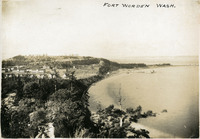 McCarthy Album 03, Photograph 063
McCarthy Album 03, Photograph 063 Caption: "Fort Worden, Wash." Washington, c. 1908.Construction of Fort Worden in Port Townsend, Washington, on Admiralty Inlet of Puget Sound began in 1898, and by 1902 it was serving as an active U.S. Army base. Fort Worden was part of the "triangle of fire", three coastal defense fortifications (Fort Casey, Fort Worden, and Fort Flagler) guarding the entrance to Puget Sound. The U.S. sold the property to the state of Washington in 1957. In 1973, the fort and surrounding area opened as Fort Worden State Park.
-
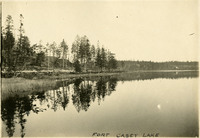 McCarthy Album 03, Photograph 062
McCarthy Album 03, Photograph 062 Caption: "Fort Casey Lake," Washington, c. 1908. Peaceful scene at Crockett Lake near Fort Casey, the water so still that the trees and surrounding hills are clearly reflected in the lake's waters.
-
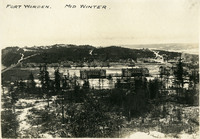 McCarthy Album 03, Photograph 061
McCarthy Album 03, Photograph 061 Caption: "Fort Worden. Mid Winter." Construction of Fort Worden in Port Townsend, Washington, on Admiralty Inlet of Puget Sound began in 1898, and by 1902 it was serving as an active U.S. Army base. Fort Worden was part of the "triangle of fire", three coastal defense fortifications (Fort Casey, Fort Worden, and Fort Flagler) guarding the entrance to Puget Sound. The U.S. sold the property to the state of Washington in 1957. In 1973, the fort and surrounding area opened as Fort Worden State Park.
-
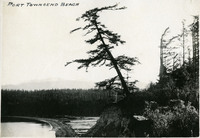 McCarthy Album 03, Photograph 060
McCarthy Album 03, Photograph 060 Caption: "Port Townsend Beach," Washington, c. 1909.
-
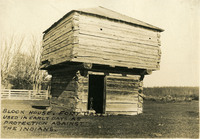 McCarthy Album 03, Photograph 059
McCarthy Album 03, Photograph 059 Caption: " Block House, Fort Casey. Used in Early Days as Protection Against the Indians." Washington, c. 1909. View of a blockhouse, a timber structure built by European settlers to guard against attack during the Indian Wars of 1855-1857.
-
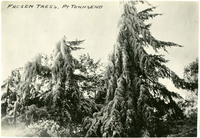 McCarthy Album 03, Photograph 058
McCarthy Album 03, Photograph 058 Caption: "Frozen Trees. Pt Townsend," Washington, c. 1909.
-
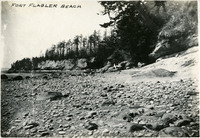 McCarthy Album 03, Photograph 057
McCarthy Album 03, Photograph 057 Caption: "Fort Flagler Beach," Washington, c. 1909.
-
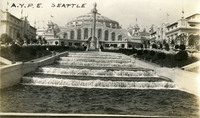 McCarthy Album 03, Photograph 056
McCarthy Album 03, Photograph 056 Caption: "A.Y.P.E. Seattle." Cascading fountains at the Alaska-Yukon-Pacific Exposition. The Alaska-Yukon-Pacific Exposition was held in Seattle, Washington in 1909 to celebrate the development of the Pacific Northwest. The fair attracted 3.7 million visitors over the course of its run from June to October 1909. Although most of the fair's buildings have since been destroyed, several of them now serve as part of the University of Washington campus.
-
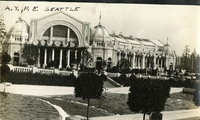 McCarthy Album 03, Photograph 055
McCarthy Album 03, Photograph 055 Caption: "A.Y.P.E. Seattle." Exposition building at the Alaska-Yukon-Pacific Exposition. The Alaska-Yukon-Pacific Exposition was held in Seattle, Washington in 1909 to celebrate the development of the Pacific Northwest. The fair attracted 3.7 million visitors over the course of its run from June to October 1909. Although most of the fair's buildings have since been destroyed, several of them now serve as part of the University of Washington campus.
-
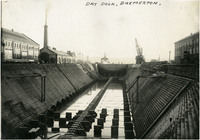 McCarthy Album 03, Photograph 054
McCarthy Album 03, Photograph 054 Caption: "Dry Dock, Bremerton." Bremerton, Washington, c. 1908-1912. See also 96-07-08-alb08-085. View of a dry dock at the Puget Sound Naval Shipyard in Bremerton, Washington. Established in 1891 as a naval station, it became Naval Yard Puget Sound in 1901. During World War I the shipyard constructed hundreds of ships to support the war effort, while in World War II, the shipyard was dedicated primarily to repairing damaged ships. Today, it contains a portion of the U.S. Navy's mothball fleet (ships retired but retained in case of future need), as well as building, repairing, and maintaining sea-going vessels of all kinds.
-
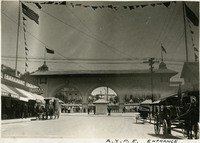 McCarthy Album 03, Photograph 053
McCarthy Album 03, Photograph 053 Caption: "A.Y.P.E. Entrance." See also 96-07-08-alb08-121. The Alaska-Yukon-Pacific Exposition was held in Seattle, Washington in 1909 to celebrate the development of the Pacific Northwest. The fair attracted 3.7 million visitors over the course of its run from June to October 1909. Although most of the fair's buildings have since been destroyed, several of them now serve as part of the University of Washington campus.
-
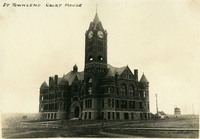 McCarthy Album 03, Photograph 052
McCarthy Album 03, Photograph 052 Caption: "Pt. Townsend Court House," Washington, c. 1908. See also 96-07-08-alb08-033. View of the Jefferson County Courthouse in Port Townsend, Washington. Built the early 1890s (W.A. Ritchie, architect), the Romanesque-style building features a 124-foot clock tower, red bricks from St. Louis, and sandstone from Alaska.
-
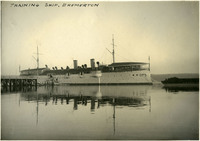 McCarthy Album 03, Photograph 051
McCarthy Album 03, Photograph 051 Caption: "Training Ship. Bremerton," Washington, c. 1908 - 1912. See also 96-07-08-alb08-086. View of the USS Philadelphia (C-4). The fourth ship to bear the name, the Philadelphia first launched in September 1889. She sailed as part of the U.S. Navy's Atlantic Squadron until 1893. She then sailed into the Pacific Ocean, where she served until being decommissioned and docked in Puget Sound in 1902. In 1904, the Navy "housed over" the ship (adding the roofed quarters visible on the upper deck in the photograph) and designated her a receiving ship for new sailors not yet assigned to a crew. The Philadelphia served in this capacity until 1912. After a brief stint as a prison ship, the Philadelphia again became a receiving ship in 1916. The Navy sold her in 1927.
 McCarthy Album 03, Photograph 100 Caption: "Vendome San Jose," c. 1910, was a luxury hotel in San Jose that opened in 1889. It was purchased by a real estate syndicate in 1930 and subsequently demolished in order to subdivide the property into lots for residential housing.
McCarthy Album 03, Photograph 100 Caption: "Vendome San Jose," c. 1910, was a luxury hotel in San Jose that opened in 1889. It was purchased by a real estate syndicate in 1930 and subsequently demolished in order to subdivide the property into lots for residential housing. McCarthy Album 03, Photograph 099 Caption: "Palace of Fine Arts, Dome," built for the Panama-Pacific International Exposition, 1915.
McCarthy Album 03, Photograph 099 Caption: "Palace of Fine Arts, Dome," built for the Panama-Pacific International Exposition, 1915. McCarthy Album 03, Photograph 098 Caption: "Gun Drill, Field Artillery," Unidentified location, undated.
McCarthy Album 03, Photograph 098 Caption: "Gun Drill, Field Artillery," Unidentified location, undated. McCarthy Album 03, Photograph 097 Caption: "Wave on Bakers [sic] Beach Presidio," San Francisco, c. 1906.
McCarthy Album 03, Photograph 097 Caption: "Wave on Bakers [sic] Beach Presidio," San Francisco, c. 1906. McCarthy Album 03, Photograph 096 Caption: "Spanish War Veteran Statue," shows the Spanish-American War Memorial in San Francisco, c. 1906.
McCarthy Album 03, Photograph 096 Caption: "Spanish War Veteran Statue," shows the Spanish-American War Memorial in San Francisco, c. 1906. McCarthy Album 03, Photograph 095 Caption: "City Hall Ruins," shows the gutted San Francisco City Hall after the 1906 earthquake and fires. Considered one of the worst natural disasters in the country's history, the 1906 San Francisco earthquake and resulting fires killed an estimated 3,000 people and destroyed over 500 city blocks, leaving approximately 200,000 residents homeless.
McCarthy Album 03, Photograph 095 Caption: "City Hall Ruins," shows the gutted San Francisco City Hall after the 1906 earthquake and fires. Considered one of the worst natural disasters in the country's history, the 1906 San Francisco earthquake and resulting fires killed an estimated 3,000 people and destroyed over 500 city blocks, leaving approximately 200,000 residents homeless. McCarthy Album 03, Photograph 094 Caption: "Santa Fe Depot, Stockton," c. 1906. The Santa Fe Depot (William Benson Storey, architect) was completed in 1899 for the Atchison, Topeka, and Santa Fe Railway. Added to the National Register of Historic Places in 1976, the depot was renovated and restored it to its original design, and reopened in 2005.
McCarthy Album 03, Photograph 094 Caption: "Santa Fe Depot, Stockton," c. 1906. The Santa Fe Depot (William Benson Storey, architect) was completed in 1899 for the Atchison, Topeka, and Santa Fe Railway. Added to the National Register of Historic Places in 1976, the depot was renovated and restored it to its original design, and reopened in 2005. McCarthy Album 03, Photograph 093 Caption: "Oakland City Hall," Oakland, California, c. 1910. Completed in 1879, the building was Oakland's second city hall and served until it was demolished in 1914 to create City Hall Plaza in front of the new City Hall that had been completed that year.
McCarthy Album 03, Photograph 093 Caption: "Oakland City Hall," Oakland, California, c. 1910. Completed in 1879, the building was Oakland's second city hall and served until it was demolished in 1914 to create City Hall Plaza in front of the new City Hall that had been completed that year. McCarthy Album 03, Photograph 092 Caption: "Stockton Asylum Grounds," Stockton, California, c. 1906. The Stockton Insane Asylum was established in 1851, completed in 1853, and was the first public mental health hospital in California. It remained a functioning state hospital until 1995.
McCarthy Album 03, Photograph 092 Caption: "Stockton Asylum Grounds," Stockton, California, c. 1906. The Stockton Insane Asylum was established in 1851, completed in 1853, and was the first public mental health hospital in California. It remained a functioning state hospital until 1995. McCarthy Album 03, Photograph 091 Caption: "Santa Fe Trestle, Alhambra Valley," Martinez, Contra Costa County, California, c. 1906.
McCarthy Album 03, Photograph 091 Caption: "Santa Fe Trestle, Alhambra Valley," Martinez, Contra Costa County, California, c. 1906. McCarthy Album 03, Photograph 090 Caption: "Refugee Hut," shows four people standing in the doorway of a hut built after the San Francisco earthquake of April 18, 1906. Considered one of the worst natural disasters in the country's history, the 1906 San Francisco earthquake and resulting fires killed an estimated 3,000 people and destroyed over 500 city blocks, leaving approximately 200,000 residents homeless.
McCarthy Album 03, Photograph 090 Caption: "Refugee Hut," shows four people standing in the doorway of a hut built after the San Francisco earthquake of April 18, 1906. Considered one of the worst natural disasters in the country's history, the 1906 San Francisco earthquake and resulting fires killed an estimated 3,000 people and destroyed over 500 city blocks, leaving approximately 200,000 residents homeless. McCarthy Album 03, Photograph 089 Caption: "Benicia Arsenal Entrance," c. 1905, Benicia, California. William McCarthy began his career as an inspector of armaments for the U.S. War Department at the Benicia Arsenal in 1903. The arsenal was established in 1851 as the first Ordnance Supply Depot in the West, from which it supplied and supported U.S. troops, from the Civil War through WWII and the Korean War. It was deactivated in 1963.
McCarthy Album 03, Photograph 089 Caption: "Benicia Arsenal Entrance," c. 1905, Benicia, California. William McCarthy began his career as an inspector of armaments for the U.S. War Department at the Benicia Arsenal in 1903. The arsenal was established in 1851 as the first Ordnance Supply Depot in the West, from which it supplied and supported U.S. troops, from the Civil War through WWII and the Korean War. It was deactivated in 1963. McCarthy Album 03, Photograph 088 Caption: "Call Building Burning," shows the Call Building on Market and 3rd Streets on fire after the earthquake, with people and horses in the foreground. Considered one of the worst natural disasters in the country's history, the 1906 San Francisco earthquake and resulting fires killed an estimated 3,000 people and destroyed over 500 city blocks, leaving approximately 200,000 residents homeless.
McCarthy Album 03, Photograph 088 Caption: "Call Building Burning," shows the Call Building on Market and 3rd Streets on fire after the earthquake, with people and horses in the foreground. Considered one of the worst natural disasters in the country's history, the 1906 San Francisco earthquake and resulting fires killed an estimated 3,000 people and destroyed over 500 city blocks, leaving approximately 200,000 residents homeless. McCarthy Album 03, Photograph 087 Caption: "Market St. S.F." Shows Market Street with intact buildings, trolleys, horse-drawn buggies and carriages, and people milling about. Most likely before the April 18, 1906 earthquake. C. 1905.
McCarthy Album 03, Photograph 087 Caption: "Market St. S.F." Shows Market Street with intact buildings, trolleys, horse-drawn buggies and carriages, and people milling about. Most likely before the April 18, 1906 earthquake. C. 1905. McCarthy Album 03, Photograph 086 Caption: "San Francisco April 22, 1906. Center of Town." Shows the city center in ruins after the earthquake and fires. Considered one of the worst natural disasters in the country's history, the 1906 San Francisco earthquake and resulting fires killed an estimated 3,000 people and destroyed over 500 city blocks, leaving approximately 200,000 residents homeless.
McCarthy Album 03, Photograph 086 Caption: "San Francisco April 22, 1906. Center of Town." Shows the city center in ruins after the earthquake and fires. Considered one of the worst natural disasters in the country's history, the 1906 San Francisco earthquake and resulting fires killed an estimated 3,000 people and destroyed over 500 city blocks, leaving approximately 200,000 residents homeless. McCarthy Album 03, Photograph 085 Caption: "San Francisco April 18, 1906. Center of Town. The Awful Fire after the Shake." Shows much smoke with buildings on fire in the center of the city, after the earthquake. Considered one of the worst natural disasters in the country's history, the 1906 San Francisco earthquake and resulting fires killed an estimated 3,000 people and destroyed over 500 city blocks, leaving approximately 200,000 residents homeless.
McCarthy Album 03, Photograph 085 Caption: "San Francisco April 18, 1906. Center of Town. The Awful Fire after the Shake." Shows much smoke with buildings on fire in the center of the city, after the earthquake. Considered one of the worst natural disasters in the country's history, the 1906 San Francisco earthquake and resulting fires killed an estimated 3,000 people and destroyed over 500 city blocks, leaving approximately 200,000 residents homeless. McCarthy Album 03, Photograph 084 Caption: "The City Disaster." Photograph of The Seattle Daily Times front page and photographs of the San Francisco earthquake's aftermath with headline: "City Wiped Out! Fire Still Raging!" Dated April 20, 1906.
McCarthy Album 03, Photograph 084 Caption: "The City Disaster." Photograph of The Seattle Daily Times front page and photographs of the San Francisco earthquake's aftermath with headline: "City Wiped Out! Fire Still Raging!" Dated April 20, 1906. McCarthy Album 03, Photograph 083 Caption: "The California. " c. 1906. This photograph shows the second U.S. Navy ship to bear the Golden State's name. Launched in 1904 and commissioned in 1907, this Pennsylvania-class armored cruiser served in the Pacific fleet. Her name was changed in 1914 to the USS San Diego, in order to free up the name for a new, Tennessee-class battleship. The USS San Diego went on to serve in both the Pacific and Atlantic fleets during World War I, until being sunk off the coast of New York by a German mine in 1918, with a loss of six lives.
McCarthy Album 03, Photograph 083 Caption: "The California. " c. 1906. This photograph shows the second U.S. Navy ship to bear the Golden State's name. Launched in 1904 and commissioned in 1907, this Pennsylvania-class armored cruiser served in the Pacific fleet. Her name was changed in 1914 to the USS San Diego, in order to free up the name for a new, Tennessee-class battleship. The USS San Diego went on to serve in both the Pacific and Atlantic fleets during World War I, until being sunk off the coast of New York by a German mine in 1918, with a loss of six lives. McCarthy Album 03, Photograph 082 Caption: "Bow of the Connecticut," unidentified location, undated.
McCarthy Album 03, Photograph 082 Caption: "Bow of the Connecticut," unidentified location, undated. McCarthy Album 03, Photograph 081 Caption: "Stockton Asylum." Stockton, California, c. 1906. The Stockton Insane Asylum was established in 1851, completed in 1853, and was the first public mental health hospital in California. It remained a functioning state hospital until 1995.
McCarthy Album 03, Photograph 081 Caption: "Stockton Asylum." Stockton, California, c. 1906. The Stockton Insane Asylum was established in 1851, completed in 1853, and was the first public mental health hospital in California. It remained a functioning state hospital until 1995. McCarthy Album 03, Photograph 080 Caption: "Cliff House." People standing on Ocean Beach watching the third Cliff House burning in San Francisco, in 1907. The original Cliff House was built in 1858. The second was built in 1863 and was destroyed by fire on Christmas day in 1894. The third Victorian- style Cliff House was completed in 1896, and although it survived the 1906 earthquake and fires, it burned to the ground in 1907, as seen in this image. A fourth Cliff House was then built with steel-reinforced concrete and opened in 1909.
McCarthy Album 03, Photograph 080 Caption: "Cliff House." People standing on Ocean Beach watching the third Cliff House burning in San Francisco, in 1907. The original Cliff House was built in 1858. The second was built in 1863 and was destroyed by fire on Christmas day in 1894. The third Victorian- style Cliff House was completed in 1896, and although it survived the 1906 earthquake and fires, it burned to the ground in 1907, as seen in this image. A fourth Cliff House was then built with steel-reinforced concrete and opened in 1909. McCarthy Album 03, Photograph 079 Caption: "Chetzemoka Park. Port Townsend." Washington, c. 1905.
McCarthy Album 03, Photograph 079 Caption: "Chetzemoka Park. Port Townsend." Washington, c. 1905. McCarthy Album 03, Photograph 078 Caption: "Big Trees Santa Cruz." General Grant, located in the Santa Cruz Big Tree Grove, c. 1905.
McCarthy Album 03, Photograph 078 Caption: "Big Trees Santa Cruz." General Grant, located in the Santa Cruz Big Tree Grove, c. 1905. McCarthy Album 03, Photograph 077 Caption: "Ruins of Call Building." Completed in 1898 and designed by civic leader Claus Spreckels, the Call building on the corner of 3rd and Market streets was one of the first skyscrapers in San Francisco, built to house the San Francisco Call newspaper offices. While the structure withstood the 1906 earthquake, the interior caught fire and sustained considerable damage. After major renovations, the building is today known as The Central Tower.
McCarthy Album 03, Photograph 077 Caption: "Ruins of Call Building." Completed in 1898 and designed by civic leader Claus Spreckels, the Call building on the corner of 3rd and Market streets was one of the first skyscrapers in San Francisco, built to house the San Francisco Call newspaper offices. While the structure withstood the 1906 earthquake, the interior caught fire and sustained considerable damage. After major renovations, the building is today known as The Central Tower. McCarthy Album 03, Photograph 076 Caption: "Palace Hotel Court 1905," c. 1906. (Handwritten on photograph: "copyright 1906 by W._ Wod_n."). The Palace Hotel was originally built in 1875, rebuilt in 1909, and was one of the first premier luxury hotels in San Francisco.
McCarthy Album 03, Photograph 076 Caption: "Palace Hotel Court 1905," c. 1906. (Handwritten on photograph: "copyright 1906 by W._ Wod_n."). The Palace Hotel was originally built in 1875, rebuilt in 1909, and was one of the first premier luxury hotels in San Francisco. McCarthy Album 03, Photograph 075 Caption: "St. Francis Hotel," c. 1905. St. Francis Hotel at Union Square and the Dewey Monument in the foreground (Robert I. Aitken, sculptor), which commemorated U.S. Admiral George Dewey's naval victory at the battle of Manila Bay during the Spanish American War of 1898. The luxury hotel opened in 1904 and fortunately suffered little damage from the 1906 earthquake. It was expanded in 1913, and 1972, making it one of the largest hotels in the city.
McCarthy Album 03, Photograph 075 Caption: "St. Francis Hotel," c. 1905. St. Francis Hotel at Union Square and the Dewey Monument in the foreground (Robert I. Aitken, sculptor), which commemorated U.S. Admiral George Dewey's naval victory at the battle of Manila Bay during the Spanish American War of 1898. The luxury hotel opened in 1904 and fortunately suffered little damage from the 1906 earthquake. It was expanded in 1913, and 1972, making it one of the largest hotels in the city. McCarthy Album 03, Photograph 074 Caption: "Stow Lake," in Golden Gate Park, San Francisco, c. 1910. Stow lake is a manmade lake in Golden Gate Park dating back to 1893. Visitors still enjoy Stow Lake today, engaging in activities such as boating and picnicking by the lake.
McCarthy Album 03, Photograph 074 Caption: "Stow Lake," in Golden Gate Park, San Francisco, c. 1910. Stow lake is a manmade lake in Golden Gate Park dating back to 1893. Visitors still enjoy Stow Lake today, engaging in activities such as boating and picnicking by the lake. McCarthy Album 03, Photograph 073 Caption: "Shasta Springs," Siskiyou County, California, c. 1906. Shasta Springs, just north of Dunsmuir, California, in the Trinity Mountains, was a resort area in the late nineteenth and early twentieth centuries. It centered around natural springs, which became a featured stop on the Southern Pacific Railroad's Shasta Route. The resort operated until the 1950s, when it was purchased by private interests.
McCarthy Album 03, Photograph 073 Caption: "Shasta Springs," Siskiyou County, California, c. 1906. Shasta Springs, just north of Dunsmuir, California, in the Trinity Mountains, was a resort area in the late nineteenth and early twentieth centuries. It centered around natural springs, which became a featured stop on the Southern Pacific Railroad's Shasta Route. The resort operated until the 1950s, when it was purchased by private interests. McCarthy Album 03, Photograph 072 Caption: "Fillmore St. Dec 10, 1906." Shows the Fillmore Street area flooded, San Francisco, 1906.
McCarthy Album 03, Photograph 072 Caption: "Fillmore St. Dec 10, 1906." Shows the Fillmore Street area flooded, San Francisco, 1906. McCarthy Album 03, Photograph 071 Caption: "The Massachusetts," Ship designed for coastal defense. Unidentified location, undated.
McCarthy Album 03, Photograph 071 Caption: "The Massachusetts," Ship designed for coastal defense. Unidentified location, undated. McCarthy Album 03, Photograph 070 Caption: "Old City Hall Tower," San Francisco, c. 1905. A view of the San Francisco City Hall, built in 1870, before it was damaged beyond repair by the 1906 earthquake and fires. A new city hall, near the site of the original, was completed in 1916.
McCarthy Album 03, Photograph 070 Caption: "Old City Hall Tower," San Francisco, c. 1905. A view of the San Francisco City Hall, built in 1870, before it was damaged beyond repair by the 1906 earthquake and fires. A new city hall, near the site of the original, was completed in 1916. McCarthy Album 03, Photograph 069 Caption: "On Shasta Route," Siskiyou County, California, c. 1905
McCarthy Album 03, Photograph 069 Caption: "On Shasta Route," Siskiyou County, California, c. 1905 McCarthy Album 03, Photograph 068 Caption: "Trestle in Oregon." c. 1905
McCarthy Album 03, Photograph 068 Caption: "Trestle in Oregon." c. 1905 McCarthy Album 03, Photograph 067 Caption: " Parliament Building Victoria B.C." c. 1909. Constructed in the Neo-baroque, Renaissance Revival and Romanesque Revival architectural style (Francis Rattenbury, architect), the British Columbia Parliament Buildings were completed in 1897, and are home to the Legislative Assembly of British Columbia.
McCarthy Album 03, Photograph 067 Caption: " Parliament Building Victoria B.C." c. 1909. Constructed in the Neo-baroque, Renaissance Revival and Romanesque Revival architectural style (Francis Rattenbury, architect), the British Columbia Parliament Buildings were completed in 1897, and are home to the Legislative Assembly of British Columbia. McCarthy Album 03, Photograph 066 Caption: "S.P. Shasta Route." Southern Pacific train on the Shasta route with Mt. Shasta in the background, c. 1905.
McCarthy Album 03, Photograph 066 Caption: "S.P. Shasta Route." Southern Pacific train on the Shasta route with Mt. Shasta in the background, c. 1905. McCarthy Album 03, Photograph 065 Caption: "Fort Casey Light House, Wash." c. 1905. Located on Whidbey Island in Puget Sound, the Admiralty Head Lighthouse was built overlooking Admiralty Inlet in 1903. It replaced an earlier structure that had to be moved in 1890 to accommodate the construction of Fort Casey. The second lighthouse, shown here, was built with thick walls in order to withstand earthquakes and the concussion of guns at Fort Casey. The man shown in the photograph is likely Charles H. Davis, who was appointed keeper of the lighthouse in 1900 and served until his death in 1914. The lighthouse, deactivated in 1922, has since been restored by Washington State Parks, and is part of the Fort Casey State Park.
McCarthy Album 03, Photograph 065 Caption: "Fort Casey Light House, Wash." c. 1905. Located on Whidbey Island in Puget Sound, the Admiralty Head Lighthouse was built overlooking Admiralty Inlet in 1903. It replaced an earlier structure that had to be moved in 1890 to accommodate the construction of Fort Casey. The second lighthouse, shown here, was built with thick walls in order to withstand earthquakes and the concussion of guns at Fort Casey. The man shown in the photograph is likely Charles H. Davis, who was appointed keeper of the lighthouse in 1900 and served until his death in 1914. The lighthouse, deactivated in 1922, has since been restored by Washington State Parks, and is part of the Fort Casey State Park. McCarthy Album 03, Photograph 064 Caption: "Totem Pole, Seattle." Seattle, Washington, c. 1905. View of the Tlingit totem pole in Seattle's Pioneer Square. The totem pole was stolen in 1899 by a group of businessmen, and erected in the square, then known as Pioneer Place. An arsonist destroyed this pole in 1938, but it was later replaced by another carved by the Tlingit tribe (who were also finally paid for the original pole).
McCarthy Album 03, Photograph 064 Caption: "Totem Pole, Seattle." Seattle, Washington, c. 1905. View of the Tlingit totem pole in Seattle's Pioneer Square. The totem pole was stolen in 1899 by a group of businessmen, and erected in the square, then known as Pioneer Place. An arsonist destroyed this pole in 1938, but it was later replaced by another carved by the Tlingit tribe (who were also finally paid for the original pole). McCarthy Album 03, Photograph 063 Caption: "Fort Worden, Wash." Washington, c. 1908.Construction of Fort Worden in Port Townsend, Washington, on Admiralty Inlet of Puget Sound began in 1898, and by 1902 it was serving as an active U.S. Army base. Fort Worden was part of the "triangle of fire", three coastal defense fortifications (Fort Casey, Fort Worden, and Fort Flagler) guarding the entrance to Puget Sound. The U.S. sold the property to the state of Washington in 1957. In 1973, the fort and surrounding area opened as Fort Worden State Park.
McCarthy Album 03, Photograph 063 Caption: "Fort Worden, Wash." Washington, c. 1908.Construction of Fort Worden in Port Townsend, Washington, on Admiralty Inlet of Puget Sound began in 1898, and by 1902 it was serving as an active U.S. Army base. Fort Worden was part of the "triangle of fire", three coastal defense fortifications (Fort Casey, Fort Worden, and Fort Flagler) guarding the entrance to Puget Sound. The U.S. sold the property to the state of Washington in 1957. In 1973, the fort and surrounding area opened as Fort Worden State Park. McCarthy Album 03, Photograph 062 Caption: "Fort Casey Lake," Washington, c. 1908. Peaceful scene at Crockett Lake near Fort Casey, the water so still that the trees and surrounding hills are clearly reflected in the lake's waters.
McCarthy Album 03, Photograph 062 Caption: "Fort Casey Lake," Washington, c. 1908. Peaceful scene at Crockett Lake near Fort Casey, the water so still that the trees and surrounding hills are clearly reflected in the lake's waters. McCarthy Album 03, Photograph 061 Caption: "Fort Worden. Mid Winter." Construction of Fort Worden in Port Townsend, Washington, on Admiralty Inlet of Puget Sound began in 1898, and by 1902 it was serving as an active U.S. Army base. Fort Worden was part of the "triangle of fire", three coastal defense fortifications (Fort Casey, Fort Worden, and Fort Flagler) guarding the entrance to Puget Sound. The U.S. sold the property to the state of Washington in 1957. In 1973, the fort and surrounding area opened as Fort Worden State Park.
McCarthy Album 03, Photograph 061 Caption: "Fort Worden. Mid Winter." Construction of Fort Worden in Port Townsend, Washington, on Admiralty Inlet of Puget Sound began in 1898, and by 1902 it was serving as an active U.S. Army base. Fort Worden was part of the "triangle of fire", three coastal defense fortifications (Fort Casey, Fort Worden, and Fort Flagler) guarding the entrance to Puget Sound. The U.S. sold the property to the state of Washington in 1957. In 1973, the fort and surrounding area opened as Fort Worden State Park. McCarthy Album 03, Photograph 060 Caption: "Port Townsend Beach," Washington, c. 1909.
McCarthy Album 03, Photograph 060 Caption: "Port Townsend Beach," Washington, c. 1909. McCarthy Album 03, Photograph 059 Caption: " Block House, Fort Casey. Used in Early Days as Protection Against the Indians." Washington, c. 1909. View of a blockhouse, a timber structure built by European settlers to guard against attack during the Indian Wars of 1855-1857.
McCarthy Album 03, Photograph 059 Caption: " Block House, Fort Casey. Used in Early Days as Protection Against the Indians." Washington, c. 1909. View of a blockhouse, a timber structure built by European settlers to guard against attack during the Indian Wars of 1855-1857. McCarthy Album 03, Photograph 058 Caption: "Frozen Trees. Pt Townsend," Washington, c. 1909.
McCarthy Album 03, Photograph 058 Caption: "Frozen Trees. Pt Townsend," Washington, c. 1909. McCarthy Album 03, Photograph 057 Caption: "Fort Flagler Beach," Washington, c. 1909.
McCarthy Album 03, Photograph 057 Caption: "Fort Flagler Beach," Washington, c. 1909. McCarthy Album 03, Photograph 056 Caption: "A.Y.P.E. Seattle." Cascading fountains at the Alaska-Yukon-Pacific Exposition. The Alaska-Yukon-Pacific Exposition was held in Seattle, Washington in 1909 to celebrate the development of the Pacific Northwest. The fair attracted 3.7 million visitors over the course of its run from June to October 1909. Although most of the fair's buildings have since been destroyed, several of them now serve as part of the University of Washington campus.
McCarthy Album 03, Photograph 056 Caption: "A.Y.P.E. Seattle." Cascading fountains at the Alaska-Yukon-Pacific Exposition. The Alaska-Yukon-Pacific Exposition was held in Seattle, Washington in 1909 to celebrate the development of the Pacific Northwest. The fair attracted 3.7 million visitors over the course of its run from June to October 1909. Although most of the fair's buildings have since been destroyed, several of them now serve as part of the University of Washington campus. McCarthy Album 03, Photograph 055 Caption: "A.Y.P.E. Seattle." Exposition building at the Alaska-Yukon-Pacific Exposition. The Alaska-Yukon-Pacific Exposition was held in Seattle, Washington in 1909 to celebrate the development of the Pacific Northwest. The fair attracted 3.7 million visitors over the course of its run from June to October 1909. Although most of the fair's buildings have since been destroyed, several of them now serve as part of the University of Washington campus.
McCarthy Album 03, Photograph 055 Caption: "A.Y.P.E. Seattle." Exposition building at the Alaska-Yukon-Pacific Exposition. The Alaska-Yukon-Pacific Exposition was held in Seattle, Washington in 1909 to celebrate the development of the Pacific Northwest. The fair attracted 3.7 million visitors over the course of its run from June to October 1909. Although most of the fair's buildings have since been destroyed, several of them now serve as part of the University of Washington campus. McCarthy Album 03, Photograph 054 Caption: "Dry Dock, Bremerton." Bremerton, Washington, c. 1908-1912. See also 96-07-08-alb08-085. View of a dry dock at the Puget Sound Naval Shipyard in Bremerton, Washington. Established in 1891 as a naval station, it became Naval Yard Puget Sound in 1901. During World War I the shipyard constructed hundreds of ships to support the war effort, while in World War II, the shipyard was dedicated primarily to repairing damaged ships. Today, it contains a portion of the U.S. Navy's mothball fleet (ships retired but retained in case of future need), as well as building, repairing, and maintaining sea-going vessels of all kinds.
McCarthy Album 03, Photograph 054 Caption: "Dry Dock, Bremerton." Bremerton, Washington, c. 1908-1912. See also 96-07-08-alb08-085. View of a dry dock at the Puget Sound Naval Shipyard in Bremerton, Washington. Established in 1891 as a naval station, it became Naval Yard Puget Sound in 1901. During World War I the shipyard constructed hundreds of ships to support the war effort, while in World War II, the shipyard was dedicated primarily to repairing damaged ships. Today, it contains a portion of the U.S. Navy's mothball fleet (ships retired but retained in case of future need), as well as building, repairing, and maintaining sea-going vessels of all kinds. McCarthy Album 03, Photograph 053 Caption: "A.Y.P.E. Entrance." See also 96-07-08-alb08-121. The Alaska-Yukon-Pacific Exposition was held in Seattle, Washington in 1909 to celebrate the development of the Pacific Northwest. The fair attracted 3.7 million visitors over the course of its run from June to October 1909. Although most of the fair's buildings have since been destroyed, several of them now serve as part of the University of Washington campus.
McCarthy Album 03, Photograph 053 Caption: "A.Y.P.E. Entrance." See also 96-07-08-alb08-121. The Alaska-Yukon-Pacific Exposition was held in Seattle, Washington in 1909 to celebrate the development of the Pacific Northwest. The fair attracted 3.7 million visitors over the course of its run from June to October 1909. Although most of the fair's buildings have since been destroyed, several of them now serve as part of the University of Washington campus. McCarthy Album 03, Photograph 052 Caption: "Pt. Townsend Court House," Washington, c. 1908. See also 96-07-08-alb08-033. View of the Jefferson County Courthouse in Port Townsend, Washington. Built the early 1890s (W.A. Ritchie, architect), the Romanesque-style building features a 124-foot clock tower, red bricks from St. Louis, and sandstone from Alaska.
McCarthy Album 03, Photograph 052 Caption: "Pt. Townsend Court House," Washington, c. 1908. See also 96-07-08-alb08-033. View of the Jefferson County Courthouse in Port Townsend, Washington. Built the early 1890s (W.A. Ritchie, architect), the Romanesque-style building features a 124-foot clock tower, red bricks from St. Louis, and sandstone from Alaska. McCarthy Album 03, Photograph 051 Caption: "Training Ship. Bremerton," Washington, c. 1908 - 1912. See also 96-07-08-alb08-086. View of the USS Philadelphia (C-4). The fourth ship to bear the name, the Philadelphia first launched in September 1889. She sailed as part of the U.S. Navy's Atlantic Squadron until 1893. She then sailed into the Pacific Ocean, where she served until being decommissioned and docked in Puget Sound in 1902. In 1904, the Navy "housed over" the ship (adding the roofed quarters visible on the upper deck in the photograph) and designated her a receiving ship for new sailors not yet assigned to a crew. The Philadelphia served in this capacity until 1912. After a brief stint as a prison ship, the Philadelphia again became a receiving ship in 1916. The Navy sold her in 1927.
McCarthy Album 03, Photograph 051 Caption: "Training Ship. Bremerton," Washington, c. 1908 - 1912. See also 96-07-08-alb08-086. View of the USS Philadelphia (C-4). The fourth ship to bear the name, the Philadelphia first launched in September 1889. She sailed as part of the U.S. Navy's Atlantic Squadron until 1893. She then sailed into the Pacific Ocean, where she served until being decommissioned and docked in Puget Sound in 1902. In 1904, the Navy "housed over" the ship (adding the roofed quarters visible on the upper deck in the photograph) and designated her a receiving ship for new sailors not yet assigned to a crew. The Philadelphia served in this capacity until 1912. After a brief stint as a prison ship, the Philadelphia again became a receiving ship in 1916. The Navy sold her in 1927.